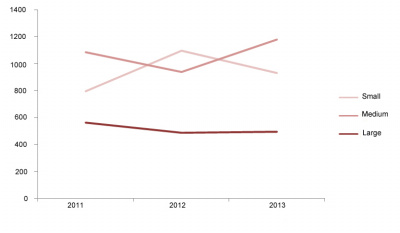Ewha increases number of small classes, acknowledging its benefits

Universities have been trying to provide more small-sized classes for students. Many scholars have demonstrated that neither “school size” nor “teacher qualifications,” but “smaller class size” is the only objective factor positively correlated with student performance. This is because students in small-sized classes can build closer relationships with professors and classmates, who can give them feedback, enabling them to make greater individual contributions to the group. Moreover, there are more opportunities for hands-on experiences, as well as more flexibility for time given to each student.
Recognizing these benefits, Ewha has also been making efforts to increase smaller classes, as numbers from the past three years show.
In the first semester of 2011, small-sized classes made up 32.52 percent of the total; medium-sized classes, 44.48 percent; and large-sized classes, 23.0 percent.
In the first semester of 2012, classes with a student capacity of 50 and below increased 3.66 percent, from 77.0 to 80.66 percent, with those of 20 and below increasing 10.94 percent, from 32.52 to 43.46 percent. By contrast, those with medium-sized classes decreased 7.28 percent, from 44.48 to 37.2 percent, and those classified as large-sized courses, with a student capacity above 50 decreased 3.66 percent, from 23.0 percent to 19.34 percent.
In the first semester of 2013, classes with student capacity of 50 and below increased 0.34 percent from 80.66 percent to 81 percent, with 35.7 percent being small-sized classes and 45.3 percent being medium-sized classes. By contrast, large-sized courses decreased 0.34 percent from 19.34 to 19 percent. Although classes with a student capacity of 50 and below increased, the reversal in the percentages for small-sized classes and medium-sized classes deserves explanation.
As another effort, Ewha is
trying to provide quality courses for major-related classes. Most major-related courses were provided in smaller or medium sizes than Liberal Arts and College Basic courses were.
This spring semester, 81.8 percent of major courses, 75 percent of major foundation courses and 100 percent of major courses for Teacher Training programs are provided in classes with a student capacity of 50 and below. By comparison, 82.3 percent of Liberal Arts courses, 66.7 percent of College Basics, and 84 percent of Teacher Training Programs for non-education majors are being provided in classes with a student capacity of 50 and below.
With smaller classes, majors can be taught in depth. Meanwhile, for College Basic classes and Liberal Arts classes, there is a relatively greater number of large-sized classes with student capacity of 50 and above. Having many large-sized classes is somewhat unavoidable, as there could be unexpected popularity of a Liberal Arts class, or an unpredictable number of students choosing a second major in a certain field.
However, large-sized classes are not always considered negative, as some classes such as College Basics can be taught even with a large student audience.
“There is a big possibility that Statistics, Microeconomics and Macroeconomics will each be a lecture without discussion sessions,” professor Kim Il-hyung (Business) said. “Lectures like those can be taught well enough in large-sized classes.”
* Reporters: Ahn In-kyeong and Oh Seo-jin
* E-mails: iahn@ewhain.net, seojinoh@ewhain.net.

